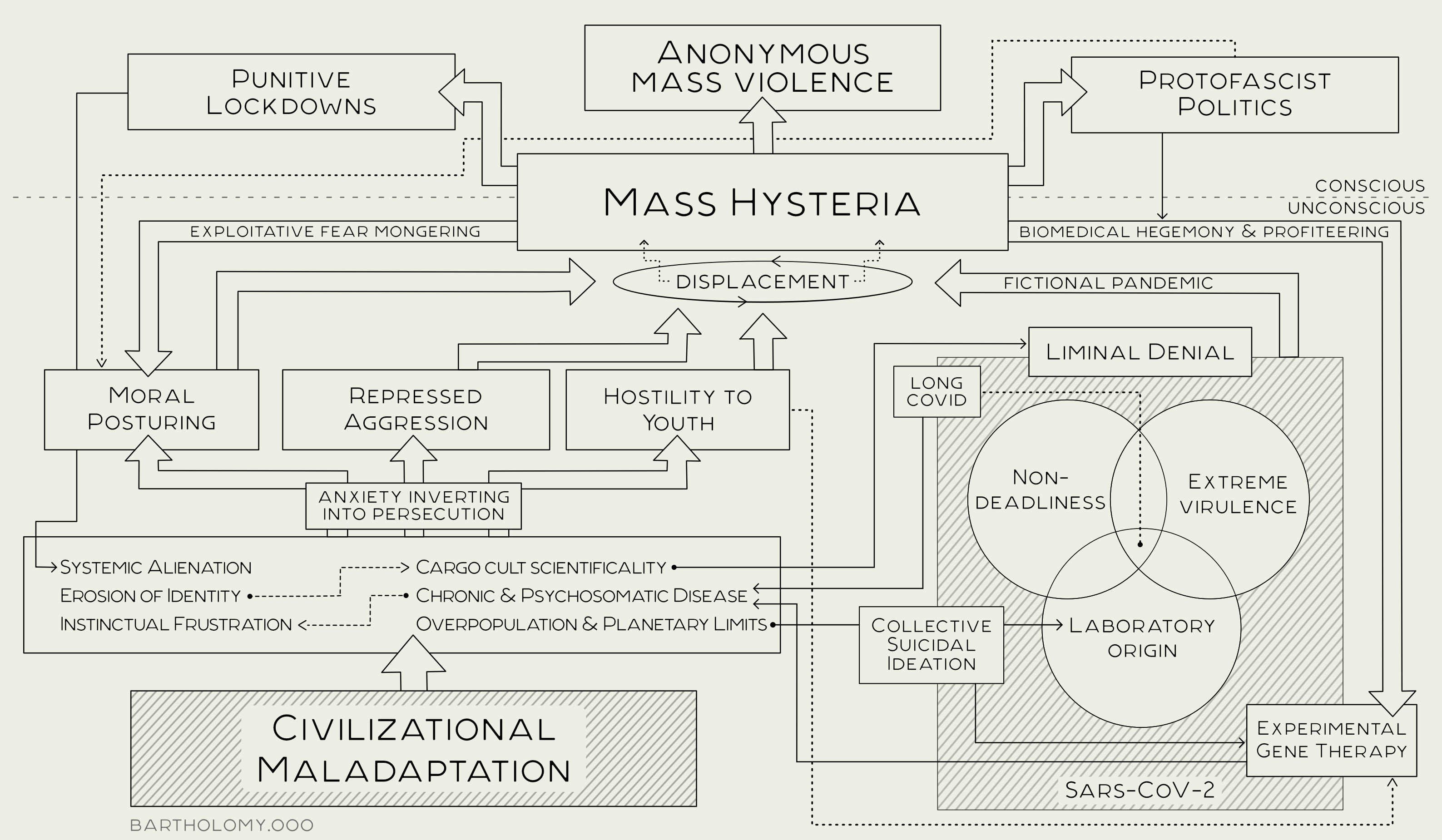Our Bodies Resonate With Maladaptative Friction
Feedback Paths of the COVID Affair

Rumour is a pipe
Blown by surmises, jealousies, conjectures,
And of so easy and so plain a stop
That the blunt monster with uncounted heads,
The still-discordant wav'ring multitude,
Can play upon it.
Henry IV Part II
It's no longer cool to talk about COVID. The central mass has moved on and the distractions multiply. There are and have been already many trajectories of denial, forgetfulness, and the redirection of blame. There was from the beginning, a barely concealed sense of embarrassment which only vanished in the midst of the most frenzied histrionics: much of it found concealment in blank-eyed obedience - the same kind which most of the population employs in its daily contortions of humiliation and drudgery. Many quietly enjoyed the irony: at least everyone finally seemed closer to an equality of punitive absurdity. This is the consolation of a traffic jam, a brutal commute, a stalled bus: everyone's in the same fix.
Why is it so important for us to fully analyze this mess? Not because we are naïve enough to believe in the machinations of justice, and not because we believe we can prevent its recurrence, but because we can prepare ourselves. The COVID affair was not isolated: it represents an emergent pattern of civilizational maladaptation which has occurred before and will again.
As I've said before, mass psychology has yet to begin as science. In order to model mass psychology as a dynamic system, we must take seriously the idea of feedback. What causes feedback? Primarily, responsive limitation: friction, orbital constraint, limited dissipative capacity. There are only so many modes of dissipation in any one system, and only so much energy any one mode can dissipate. But there is also systemic response to output: the system changes ambient environment which modulates energetic input - "self-oscillation" or negative damping.
As far as I know, no one outside the very limited sphere of the "synergetics" enthusiasm of the 80s and 90s has yet taken this idea terribly seriously in the realm of psychology. Yet in economics its a commonplace: hence bubbles, crashes, and their cycles. Worried talk about the "echo chambers" of the internet is also common enough.
Yet I seem to be alone in focusing attention on bodily misery as a causative factor - in conceiving of the human body and our collective health as a resonance chamber and a form of cultural memory, in which what we feel determines what we do which determines what we feel: I will not participate in the farcical quest for some noumenal ether in which psychology is supposed to take place, as though "the mind" were the only entity at play in mass psychology or cultural history or sociological institution - the body is at stake. What we do with our bodies in space and time: we must constantly attenuate all thinking and dreaming which does not return to this formula, and remind ourselves of what finally matters. Our intellectual life is not an end in itself, but a weapon and a weaponizing.
Firstworld misery caused the COVID affair, which amplified firstworld misery, which prepared the way for a more efficient manifestation of whatever the COVID affair was becoming before it lost coherence. The path of the tornado is still quite visible however, and the winds still swirling: the substrate is more homogeneous and prepared than previously.
Par leur puissance uniquement destructive, elles agissent comme ces microbes qui activent la dissolution des corps débilités ou des cadavres. Quand l'édifice d'une civilisation est vermoulu, ce sont toujours les foules qui en amènent l'écroulement.
In consequence of the purely destructive nature of their power, crowds act like those microbes which hasten the dissolution of enfeebled or dead bodies. When the structure of a civilisation is rotten, it is always the masses that bring about its downfall.
Gustave Le Bon, Psychologie des Foules, Introduction
The effort to blur the mirror of COVID, extends from those who want to hold government manipulation responsible, to those less clever who would like to blame "the elites", to those nearest to our camp of psychological interpretation who nonetheless miss the mark by a wide margin - on purpose.
I'm aware that the newly coined "mass formation psychosis" has gained a certain popularity. However I find in this term yet another evasive maneuver, and more symptomatic of the manifold efforts to disguise what COVID reveals than descriptive of what happened. COVID had nothing to do with psychosis. Once we understand the full implications, the inherited term "mass hysteria" is a much more fruitful and accurate place to begin a diagnosis: I only suggest the addition "aggressigenic" to emphasize the underlying causes.
It is by definition impossible for a psychosis to be shared: psychotic phenomena are characterized by a severance of social function and a reversion to idiosyncratic and novel forms of hallucination. Cases of so-called folie à deux are rare, and arise only in the context of a very intimate and dependent relationship, such as the mother-child dyad: the delusional contagion is largely just mimicry.
The psychotic stops performing socially, and instead generates novel symbolic relationships to his world, in response to an overwhelming disturbance of previous egoic structures which could no longer withstand the tension. Psychosis cannot be shared: this is the original sense of the term "idiot" - one who cannot be reached. Hysteria however, and its fundamental mechanism displacement, integrates almost seamlessly with social function in the tribal animal, which has a constant need to reassign blame and manage the delicate economy of frustrated instinct within the demands of communal living. When these frustrations reach a critical threshold, they generate an order parameter I call "ritual exclusion": enemies must be found within the tribe, because the tribe has ceased to function efficiently. I insist that all of this makes sense in a Pleistocene epoch amongst a band of 50 to 100 hominidae. It only appears monstrous, alien, and otherwise impossible to explain, in the context of an overpopulated civilization. Therefore terming the emergent COVID dynamic as "psychosis", is a symptom of not wanting to understand - to dismiss everything that happened as merely a case of contagious crazies powered by social media, and having no discernible etiology within the reality of the way we live, with our bodies, day to day.
In defining psychosis, the case of one Herr Daniel Schreber is considered canonical: if you want to know what psychosis looks and feels like, read his memoirs. In a sense, what COVID exhibits is the antipode: maximum sociality at the expense of authentic subjectivity - psychosis is nothing if not authentic and subjective. Hysteria, protofascism, and the extensible canalizations of blame share a common origin in the previously adaptive package by which the baboon-like primate troop became the cooperative hunting tribe: displacement of aggression along symbolic vectors lies right at the heart of what has made us so successful.
Either you get used to this idea, or you don't: I feel that all of this is written out in the history of the early 20th century. Rabid nationalism, scientific racism, and warmongering were at the time the shape these same forces took, in a more potently postcolonial and peak capitalistic world. Our 21st century bodies and spirits are not robust enough for these more explicitly violent eruptions: therefore displacement of aggression is more needful and salient. More hand-wringing and moral posturing is required: this is why a fictional pandemic, with all its ostensible and deeply suspicious humanitarian concern, was uniquely capable of initiating the requisite catharsis toward the final aim of anonymous mass violence.
Ultimately what we've witnessed is only a minor spasm. I only continue to bring it up because at last I understand - a great deal of what I almost refused to think about, suddenly becomes not only possible to think through but wholly necessary.
Please take a close look at the diagram accompanying this piece: it's the result of years of reflection and many productive conversations between myself and a student of mine. Every path and grouping is well considered. I'll elucidate a few special points:
The first thing to notice about the diagram is that nearly all vectors reside in the unconscious field: "unconscious" means unknown, unseen, and gains special significance through an understanding of the traceable marks of repression. And yet all these vectors are visible via their displaced representatives: the reason I know about these factors and have come to name them, is because I've learned to trace backward the paths of displacement along semantic lines. However what becomes most visible at the top of the conscious field - namely lockdowns, protofascist politics, and especially anonymous mass violence - due to their genealogy deep within the unconscious field and a long history of displacing substitution, take on an uncanny aspect in the light of day. They are never precisely what they seem to be, never what they name themselves, and always imply much more than they are ready to proclaim: "aménagements subtils d'apparence innocente". Anonymous mass violence never announces itself as such: it is always justified, rational, fair, and - most dangerous of all - compassionate.
Mass hysteria: see this piece to understand the scope of what I mean by this term. We must not allow the richness of our best psychological insight to be buried underneath the renewed effort to conceal our nature from ourselves: in other words, "hysteria" remains very much a relevant syndrome.
Exploitative fearmongering: by this phrase, we mean both media exploitation, and the many political and industrial agencies which found advantage in stoking the flames of panic. Notice that it feeds back into moral posturing, which then feeds into the swirl of displacement powering mass hysteria: a histrionic atmosphere of false postures encourages the many actors who thrive under conditions of hysteria, which further repulses and disqualifies honesty and rationality, such that those traits in the mediocre majority are suppressed. Most of humanity is not dominated by either truthfulness nor pure deception, but adapts itself to the time and place according to minimal risk. Much of the "panic" was merely mimicry: just as most belief is.
Anxiety inverting into persecution: this is one of those "discoveries" which is already common knowledge. It's actually a daily experience for most of you, and written plainly enough in history. I quote from that piece of mine on the witch-hunt:
21st century psychology is comfortable enough diagnosing the crippling anxieties of modernity - or at least in herding them into pharmaceutical dependence - but ignores and denies all signs that anxiety has a social purpose. What could the nail-biting agoraphobic, the evangelical preacher of doom, and the COVID-unvaccinated witch-hunt have to do with each other?
But the truth is that these types are deeply related and lie along a spectrum, in which the saturation of subjective anxiety dissipates proportionally to the degree of complicity in ritual exclusion and disguised mass violence: like unexpected origami, paralyzing anxiety is inverted into persecution.
Liminal denial: this is a region of partly obscured denial. We may think of it as "preconscious" falsehood: something very like the pretense involved in religious ceremony. What's involved in "belief"? A will to ignorance accommodated to a will to power: we make many things true by collectively behaving as though they are. Therefore, none of the facts shown within this region are "repressed" in the strict sense: everyone knows, as well as I do, that the virus is not deadly. What everyone does not know, are the social consequences of acknowledging what they know - but they can guess well enough.
Long COVID: notice that it emerges as a confluence of these denied factors, and yet stands slightly outside the realm of denial. But only now that the ritual coherence is dying away, is group attention turning to this reality: because a reality cannot by definition fuel a hysteria without distortion, but it does retroactively seem to confirm the seriousness of the virus and thus provide shelter from repercussion.
Punitive lockdowns: my piece on the meaning of the facemask should help.
Hostility to youth: read my diagnosis of this syndrome if you can handle the nausea.
Fictional pandemic: I'll end this tour by quoting from my profile of the conspiracy theorist:
The twin brother of the conspiracy theorist is the evangelist: he who mines the narrative for all the power it can offer, he who is is wedded to the narrative for the sake of the dowry alone, he who has found in the histrionics of COVID the motherlode of moral-political charade.
But how are these two mutually dependent? Because every evangelist needs his demons: the best enemy of a glaring monumental fiction, is a frightening exaggerated fiction. It's not that a lie cannot defeat a truth: truth is weak, multivalent, subtle, fragile - almost nothing is easier than displacing truth. A monstrous lie feeds upon truth like merely breathing - it gains no glory from pushing aside this weakling. A monster needs heroes to devour, to stage fictional battles in the sky... In the midst of the monstrosity of COVID on the one hand, and the blustering frantic conspiracy theorizing on the other, haven't we sometimes felt ourselves slipping into the cracks, into an abyss of the loneliness of quiet and complicated truth?


